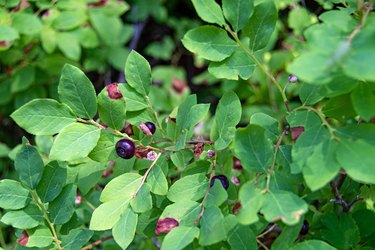
Wild huckleberries are also called western huckleberries, and they grow most prolifically in the Pacific Northwest. Western huckleberries have never been successfully domesticated, but they have many fans who pick them in nature or line up at roadside stands to buy some. They are noted for their strong, wild flavor, but that's not the only way you can distinguish wild from domesticated huckleberries.
Meet the Western Huckleberry
Video of the Day
Western huckleberries (Vaccinium membranaceum) dwell in the sunny clearings or shadowy realms of Northwestern forests, usually on slopes between 2,000 and 11,000 feet above sea level. They require some trekking to locate, but many have been willing to put in the effort, starting with the Native Americans living in the region and continuing to modern residents and bears roaming around at the end of summer looking to fill up before hibernation.
Video of the Day
Western huckleberries are related to both low and high bush blueberries, but there are some clear differences in how they grow. Each huckleberry grows alone in a leaf axil on new shoots, while blueberries grow in clusters on the prior year's wood. In addition, huckleberries are deep purple and have a distinct and intense sweet-sour flavor.
Recognize the Western Huckleberry
Part of the cult surrounding huckleberry hunting is how difficult it is finding them in the wild since the huckleberry has yet to be successfully cultivated. If you take the trouble to seek out the western huckleberry in its secret heights, you'll want to be sure it's the real thing. Experienced berry hunters have no trouble, going back summer after summer for decades to bring home a bucket or two filled with the jewel-toned berries. Beginners, however, may need some tips and description.
Western huckleberry shrubs grow between 1 and 6 feet tall, producing huckleberries up to 1/2 inch in diameter. The berries can look black, purple, or red. Some are shiny, while others are duller with a blue tinge. They tend to grow on sandy loam soils, with true firs, hemlocks, and bear grass for neighbors. The shrubs are often found on clear-cut areas and old burn sites. They prefer partial shade but can occasionally be seen in full sun. Before the berries arrive, the plants will bear blossoms in pink or purple.
Use the Huckleberry
Many people who pick huckleberries in the late summer and fall in the Northwest just eat the fruit raw. Like other berries, they can be tossed onto cereal, yogurt, or ice cream or just eaten by themselves, but there are a variety of other uses.
Native Americans in the Salish, Yakama, and other tribes gathered huckleberries and considered them to be a crucial part of their diet. Some tribes burned areas deliberately to allow successional plants, like huckleberries, to grow. They ate berries fresh but also dried them for winter. These were often mixed with bitterroot in stews in winter.
Incoming settlers canned the berries. Today, huckleberries are most often eaten raw, but they are also used to make jams, syrups, pies, muffins, and candies.